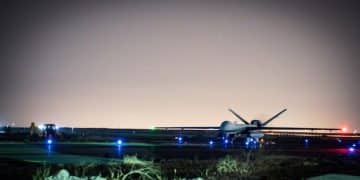US Military Adaptation to Changing European Geopolitics

The United States military is actively recalibrating its strategic posture, force structures, and technological investments in Eastern Europe to effectively counter emerging threats and support NATO allies amidst a dynamically evolving geopolitical landscape, focusing on deterrence and readiness.
The geopolitical landscape across Eastern Europe is in constant flux, marked by shifting alliances, technological advancements, and renewed great power competition. In this intricate and often unpredictable environment, understanding how the US Military is adapting to the changing geopolitical landscape in Eastern Europe is paramount. This article delves into the strategic pivots, technological enhancements, and collaborative efforts undertaken by the United States Armed Forces to maintain stability and ensure readiness in a region of increasing strategic importance.
redefining defense: strategic shifts in eastern europe
The foundational pillars of United States military engagement in Eastern Europe have historically centered on deterrence and collective defense under the NATO umbrella. However, the nature of these pillars has undergone significant redefinition in response to recent geopolitical shifts. The static, Cold War-era posture has evolved into a dynamic and flexible approach, emphasizing agility, responsiveness, and forward presence. This strategic shift acknowledges the multi-domain threats emanating from the region, encompassing conventional aggression, cyber warfare, and influence operations.
From Fortified Borders to Flexible Power Projection
Historically, military strategy often involved fixed defenses and large, permanent garrisons. Today, the focus has shifted dramatically towards expeditionary capabilities and the ability to rapidly deploy forces across vast distances. This approach minimizes the footprint while maximizing operational reach. It allows the US to project power precisely where and when needed, without being tied to static infrastructure that could become a target. This flexibility is key in an environment where threats can materialize unexpectedly and require immediate, tailored responses.
- Enhanced Rotational Presence: The US has decreased reliance on permanent bases, favoring rotational deployments of forces like armored brigades and air squadrons. This provides unpredictability to adversaries and allows for continuous training in diverse environments with allies.
- Pre-positioned Equipment Stocks: Significant investments have been made in pre-positioning equipment and supplies in key locations. This drastically reduces reaction times, enabling forces to “fly to equipment” rather than waiting for heavy gear to be shipped.
- Increased Interoperability Drills: Regular, large-scale exercises with NATO allies are critical. These drills test joint operational capabilities, communication protocols, and ensure seamless integration of forces, fostering a true collective defense posture.
Strategic Reassessment and Alliance Fortification
The US military’s adaptation is not merely about troop movements or equipment; it’s deeply rooted in a re-evaluation of its strategic objectives in the region. This involves recognizing the unique security concerns of Eastern European allies, many of whom share direct borders with potential adversaries. Building robust, resilient alliances becomes an imperative, extending beyond traditional military cooperation to include intelligence sharing, cyber defense collaboration, and joint training initiatives that strengthen the collective defense architecture.
The emphasis on tailored deterrence signals a departure from one-size-fits-all strategies. Instead, responses are calibrated to specific threats, ensuring that any potential aggressor faces a credible, proportional, and effective deterrent. This often involves a mix of conventional forces, cyber capabilities, and economic sanctions, coordinated across the NATO alliance to maximize impact.
cyber warfare and hybrid threats: the new battlespace
The contemporary security landscape in Eastern Europe is defined not only by conventional military power but increasingly by the pervasive and insidious nature of cyber warfare and hybrid threats. These encompass a broad spectrum of non-military tactics, from disinformation campaigns and cyberattacks to economic coercion and proxy conflicts, all designed to destabilize and undermine without direct military confrontation. The US military recognizes that victory in this new battlespace requires a fundamentally different approach to defense and deterrence, focusing on resilience and rapid response.

Developing Cyber Resilience and Offensive Capabilities
The reliance on digital infrastructure makes nations vulnerable to cyberattacks that can cripple essential services, disrupt command and control systems, and erode public trust. Consequently, the US military is investing heavily in enhancing its own cyber defenses, protecting critical networks and data from sophisticated state-sponsored attacks. This includes implementing advanced encryption, developing robust anomaly detection systems, and fostering a culture of cyber hygiene across all ranks.
Beyond defense, the military is also honing its offensive cyber capabilities. These capabilities are crucial for deterrence, allowing for the disruption or degradation of adversary networks and systems in times of conflict. The development of these tools is carefully balanced with international law and ethical considerations, ensuring their use is proportional and targeted. Training scenarios now regularly incorporate complex cyberattack simulations to prepare personnel for real-world contingencies, where physical and digital realms are inextricably linked.
Countering Disinformation and Influence Operations
Hybrid warfare often exploits information as a weapon, spewing disinformation to sow discord, manipulate public opinion, and destabilize societies. The US military, in collaboration with intelligence agencies and allied partners, is developing strategies to counter these pernicious campaigns. This involves not only identifying and exposing hostile propaganda but also actively promoting factual narratives and supporting independent media outlets.
The human element remains critical in this fight. Training personnel to recognize and counter disinformation, understand cultural nuances, and engage effectively with local populations is paramount. This extends to fostering digital literacy within allied nations, empowering citizens to critically evaluate information and resist manipulation. The goal is to build societal resilience against attempts to undermine democratic processes and national cohesion.
- Joint Cyber Exercises: Regular exercises with NATO allies specifically target cyber defense and response, simulating complex attack scenarios to improve coordination and technical proficiency.
- Information Sharing Platforms: Establishing secure platforms for real-time intelligence and threat data sharing among allies aids in rapid identification and mitigation of cyber and hybrid threats.
- Strategic Communications: Investing in capabilities to proactively counter disinformation and effectively communicate US and NATO objectives, ensuring factual narratives prevail.
The integration of cyber and hybrid threat considerations into every aspect of military planning is a testament to their increasing importance. The battle for the narrative and the integrity of digital systems is now as critical as any conventional military engagement, requiring continuous adaptation and innovation from the US military and its allies.
enhanced training and interoperability with nato allies
The foundation of US military effectiveness in Eastern Europe rests significantly on its ability to operate seamlessly with NATO allies. This interoperability extends beyond mere technical compatibility, encompassing shared doctrines, common training standards, and a profound mutual understanding of each other’s operational procedures and strategic cultures. The evolving geopolitical landscape has only intensified the focus on these aspects, making enhanced training and interoperability a paramount pillar of the US military’s adaptation strategy.
Joint Drills and Multinational Exercises
The frequency and complexity of joint military exercises in Eastern Europe have increased significantly. These exercises, such as “Defender Europe” series, are designed to test the rapid deployment of forces, multinational command and control, and collective defense capabilities across the vast European theatre. They simulate various scenarios, from conventional attacks to hybrid threats, pushing participants to their limits and exposing areas for improvement.
Through these drills, allied forces can refine their tactical coordination, understand equipment capabilities, and build personal relationships critical for trust and effective communication during real-world operations. The focus is not just on individual unit proficiency but on the collective cohesion of a multinational force. These exercises serve as a robust declaration of commitment to collective defense under Article 5 of the NATO treaty.
Standardization and Doctrinal Alignment
Achieving deep interoperability requires more than just training together; it demands a degree of standardization and doctrinal alignment amongst diverse forces. The US military actively works with allies to harmonize equipment, communication systems, and operational procedures. This might involve adopting NATO standard operating procedures (SOPs), participating in joint equipment procurement programs, or sharing best practices in areas like logistics and intelligence fusion.
Doctrinal alignment ensures that different national forces approach a problem with similar tactical principles and strategic objectives. This reduces confusion, streamlines decision-making, and enhances overall operational efficiency. While complete uniformity is neither feasible nor desirable, a core set of shared principles and practices is essential for effective coalition warfare.
The human element of interoperability cannot be overstated. Exchange programs, staff talks, and joint planning sessions foster a deeper understanding and trust between allied military personnel. This personal connectivity often proves invaluable when faced with unforeseen challenges in complex operational environments. The commitment to enhanced training and interoperability underscores NATO’s enduring relevance as a collective security alliance.
technological innovation: leveraging cutting-edge solutions
The modern battlefield, particularly in a region as strategically vital as Eastern Europe, is increasingly defined by technological superiority. The US military’s adaptation strategy heavily relies on leveraging cutting-edge innovations to gain and maintain a decisive advantage over potential adversaries. This goes beyond acquiring new hardware, encompassing advancements in artificial intelligence, unmanned systems, advanced connectivity, and sophisticated data analysis.
AI and Data Analytics for Enhanced Decision-Making
Artificial Intelligence (AI) is rapidly transforming military operations, from intelligence gathering to logistical support. The US military is exploring how AI can process vast amounts of data more efficiently, identifying patterns and anomalies that might escape human detection. This expedites intelligence analysis, improves threat assessment, and provides commanders with a clearer, more timely operational picture. AI can also optimize supply chains, predict equipment failures, and even assist in tactical decision-making, reducing human cognitive load in high-stress situations.
The ability to collect, process, and act upon data at an accelerated pace is a critical force multiplier. Advanced analytics tools help to distill complex information into actionable intelligence, enabling more informed and rapid responses to evolving threats. This technological edge directly contributes to both deterrence and defensive capabilities.
Unmanned Systems and Autonomous Operations
Drones, both aerial and ground-based, have revolutionized modern warfare. The US military is investing in a new generation of unmanned aerial vehicles (UAVs) and unmanned ground vehicles (UGVs) that can perform a variety of missions, from reconnaissance and surveillance to strike operations and logistical support, often with reduced risk to human personnel. Autonomous capabilities, where systems can operate largely independently, are a key focus, promising increased persistence and efficiency in complex environments.
The development extends to swarming tactics where multiple drones coordinate to achieve objectives, overwhelming adversary defenses. These systems offer flexibility, precision, and the ability to operate in contested environments where manned platforms might be too vulnerable.
- Next-Generation Sensor Technology: Deployment of advanced sensors for improved situational awareness, targeting, and early warning systems across diverse domains.
- Hyper-connected Battlefields: Investing in secure, high-bandwidth communication networks to facilitate rapid data exchange and collaborative operations across distributed forces.
- Precision Strike Capabilities: Development and deployment of more accurate and agile long-range precision fire systems, crucial for deterring aggression and responding effectively.
Embracing technological innovation is not merely about acquiring new gadgets; it’s about fundamentally rethinking how military operations are conducted. The emphasis is on networked capabilities, speed of information, and the ability to project power with unprecedented precision and efficiency, ensuring the US military remains at the forefront of defense technology in Eastern Europe.
logistics and sustainment: power projection challenges
Supporting military operations across vast distances and often austere environments presents significant logistical and sustainment challenges. For the US military in Eastern Europe, this isn’t just about moving troops and equipment; it’s about establishing resilient supply lines, ensuring continuous readiness, and maintaining a robust infrastructure capable of sustaining prolonged operations. The dynamic geopolitical landscape demands a logistics network that is not only efficient but also adaptable and scalable.
Building Resilient Supply Chains
The conventional approach to logistics often involved fixed forward operating bases and predictable supply routes. However, the current threat environment, characterized by potential interdiction and sophisticated adversary capabilities, necessitates a shift towards more diverse and resilient supply chains. This includes exploring redundant routes, utilizing multiple modes of transport (air, rail, sea, road), and strategically dispersing logistics hubs.
* Forward Stocking: Pre-positioning critical supplies, fuel, and ammunition closer to potential operational areas significantly reduces response times and logistical burdens during a crisis.
* Host Nation Support: Deepening cooperation with Eastern European allies to leverage their existing infrastructure, transportation networks, and industrial capacities for sustainment.
* Agile Logistics: Implementing technological solutions like predictive analytics and blockchain to enhance visibility and efficiency within the supply chain, allowing for rapid adjustments based on operational needs.
Maintaining Readiness and Equipment Resilience
The ability to sustain operations over time is as critical as the initial deployment. This involves ensuring equipment readiness, maintenance, and the timely provision of spare parts. The US military is investing in advanced diagnostics and predictive maintenance technologies to identify potential equipment failures before they occur, minimizing downtime and maximizing operational availability.
Furthermore, hardening equipment and command nodes against diverse threats, including cyberattacks and electronic warfare, is crucial for maintaining resilience. This includes developing robust repair and recovery capabilities forward, reducing the reliance on returning damaged equipment to distant depots. The continuous pursuit of a “ready for anything” logistical posture underpins the entire adaptive strategy in Eastern Europe.
The adaptability of logistics and sustainment operations directly impacts the credibility of the US military’s presence and its ability to act as a deterrent. Without a robust and flexible support system, even the most technologically advanced forces would be quickly hampered, making sustained investment in logistical innovation a non-negotiable imperative.
economic and diplomatic integration: a holistic approach
The US military’s strategy in Eastern Europe extends far beyond purely military considerations, embracing a holistic approach that intertwines economic and diplomatic integration. Recognizing that security is multi-faceted, the United States seeks to foster stable, prosperous, and democratic societies in the region, believing that robust economies and strong diplomatic ties serve as powerful deterrents against aggression and instability. This integrated strategy aims to build resilience from within, making nations less susceptible to external pressures and more capable of contributing to collective security.
Supporting Economic Development and Energy Independence
Economic prosperity often underpins national security. The US, through various governmental and non-governmental channels, supports economic development initiatives in Eastern European nations. This can involve promoting foreign direct investment, facilitating trade agreements, and supporting reforms that enhance transparency and combat corruption. A strong economy provides the resources for robust defense spending and creates a more stable internal environment.
Furthermore, energy independence is a critical component of national security, particularly in a region historically reliant on a single energy supplier. The US encourages diversification of energy sources and infrastructure development, reducing vulnerabilities to energy coercion and strengthening the overall resilience of its allies. This economic resilience directly supports military objectives by removing key leverage points for adversaries.
Strengthening Diplomatic Ties and Strategic Dialogue
Robust diplomatic engagement is the bedrock of strong alliances. The US actively participates in bilateral and multilateral dialogues with Eastern European nations, addressing shared security concerns, coordinating policy responses, and fostering mutual trust. This includes high-level political consultations, military-to-military talks, and regular exchanges of expertise on issues ranging from defense planning to counter-terrorism.
* Bilateral Security Assistance: Providing military aid and training programs tailored to specific allied needs, enhancing their defensive capabilities and interoperability with US forces.
* Multilateral Forums: Active participation in security-focused organizations beyond NATO, such as the OSCE, to address regional challenges and promote conflict resolution through diplomatic means.
* Public Diplomacy: Engaging with the public in allied nations to counter disinformation, explain US and NATO policies, and reinforce shared values and commitments.
This comprehensive approach acknowledges that military strength alone is insufficient to guarantee long-term security. By integrating economic and diplomatic initiatives, the US military contributes to creating a more secure, prosperous, and resilient Eastern Europe, where peace is maintained through a robust tapestry of interconnected strengths.
future outlook: sustained adaptation and emerging challenges
The adaptation of the US military in Eastern Europe is an ongoing process, not a static achievement. As the geopolitical landscape continues to evolve, so too must the strategies, capabilities, and partnerships designed to ensure regional stability. The future outlook points towards sustained adaptation, driven by emerging technological frontiers, evolving threat vectors, and the imperative to continuously refine the balance between deterrence and defense.
Navigating Emerging Technologies
The rapid pace of technological advancement means that what is cutting-edge today may be commonplace tomorrow. The US military will need to remain at the forefront of innovation, continuously assessing new technologies like quantum computing, advanced materials, and next-generation biotechnology for their potential military applications. Integrating these new capabilities into existing force structures, training regimes, and logistical networks will be a significant undertaking.
Furthermore, the rise of hypersonic weapons, advanced anti-access/area denial (A2/AD) capabilities, and sophisticated electronic warfare systems from potential adversaries will necessitate a continuous re-evaluation of defensive and offensive strategies. Staying ahead of these developments requires substantial investment in research and development, combined with agile procurement processes.
Evolving Threat Environments and Regional Dynamics
While the conventional military threat remains a concern, the future promises an even more complex tapestry of challenges. The continued proliferation of cyber and hybrid warfare tactics will demand even greater emphasis on resilience, information security, and counter-influence operations. Climate change, mass migration, and resource scarcity could also emerge as significant destabilizers, indirectly impacting regional security and requiring adaptive responses from a security perspective.
* Multi-Domain Operations: Further integration and coordination of operations across land, sea, air, space, and cyber domains to achieve synergistic effects against sophisticated adversaries.
* Information Advantage: Prioritizing the ability to gather, process, and disseminate information faster and more effectively than adversaries, ensuring decision dominance.
* Deepening Partnerships: Expanding existing alliances and forging new partnerships, including with non-NATO countries in the region, to create a broader and more robust network of security cooperation.
The future of US military engagement in Eastern Europe is one of constant evolution. It will require not only technological prowess but also strategic foresight, diplomatic dexterity, and an unwavering commitment to collaborate with allies. The goal remains clear: to deter aggression, ensure regional stability, and protect US interests and commitments through a dynamic and highly adaptable defense posture. The continuous learning and responsiveness to change will define its success.
| Key Point | Brief Description |
|---|---|
| 🌎 Strategic Shifts | Moving from static presence to flexible, rotational deployments and pre-positioned equipment for rapid response. |
| 💻 Cyber & Hybrid Threats | Investing in robust cyber defenses and offensive capabilities to counter digital warfare and disinformation campaigns. |
| 🤝 NATO Interoperability | Increased joint exercises, standardization, and doctrinal alignment to ensure seamless multinational operations. |
| 🚀 Tech Innovation | Leveraging AI, unmanned systems, and advanced connectivity for enhanced decision-making and operational advantage. |
Frequently Asked Questions About US Military Adaptation in Eastern Europe
The US military is adapting due to significant geopolitical shifts, including increased aggression from regional powers, the rise of hybrid warfare, and evolving security concerns of NATO allies. This adaptation ensures robust deterrence and readiness in a dynamically changing and strategically vital region, protecting US interests and commitments.
Hybrid threats involve a blend of conventional, unconventional, and cyber tactics, including disinformation and economic coercion, aimed at destabilizing nations without direct military conflict. The US military counters them through enhanced cyber defenses, offensive cyber capabilities, and strategic communication to expose and combat hostile narratives.
Interoperability is enhanced through frequent joint military exercises, which test rapid deployments and multinational command. It also involves standardizing equipment, communication systems, and aligning tactical doctrines. These efforts foster seamless cooperation, building trust and effectiveness among allied forces for collective defense operations.
Technological innovations are crucial for maintaining a decisive advantage. The US military leverages artificial intelligence for data analysis, employs unmanned systems for diverse missions, and develops advanced connectivity. These advancements provide superior situational awareness, precision, and operational efficiency, enhancing both deterrence and defensive capabilities in modern warfare.
Beyond direct military efforts, the US employs a holistic approach by fostering economic and diplomatic integration. This includes supporting economic development to build stable societies and promoting energy independence to reduce vulnerabilities. Strong diplomatic ties and strategic dialogue with allies further solidify regional stability and resilience against external pressures.
Conclusion
The US military’s adaptation to the evolving geopolitical landscape in Eastern Europe is a multifaceted and continuous endeavor. From refining strategic deployments and enhancing cooperation with NATO allies to pioneering advancements in cyber warfare and leveraging cutting-edge technologies, the focus remains acutely on deterrence, readiness, and resilience. This comprehensive approach, integrating military might with diplomatic and economic initiatives, underscores a deep commitment to regional stability. As challenges persist and new ones emerge, the capacity for constant evolution will undoubtedly define the US military’s enduring effectiveness in this critical theatre.





